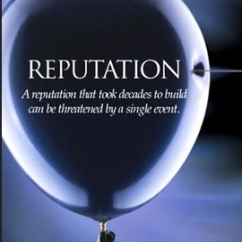Articles and News
EDITORIAL: HOW TO SURVIVE BAD PR, AND WHY YOU NEED TO BE ACTIVE ONLINE BEFORE IT HAPPENS | January 31, 2013 (0 comments)

Merrick, NY—What’s every jeweler’s nightmare? Other than being robbed at gunpoint where someone is injured (or worse), probably nothing strikes fear in the hearts of jewelers more than a negative news story, especially in the digital world where anything can go viral without warning. Just like the pin that threatens the balloon pictured at left, a single incident can threaten the reputation you've painstakingly built over generations.
In the January 22 edition of its T3 Tuesday Tips & Tricks, Michael Fruchtman, CEO of Toledo, OH-based Fruchtman Marketing offers a checklist of steps to take to deal with negative PR. He has some really great ideas that started me thinking about the topic from the perspective of an editor and a journalist.
A responsible journalist is objective and reports only verifiable facts from both sides of an issue without putting a slant on it. Good journalists are taught that if your mother says she loves you, check it out. A responsible journalist also will call you for comment before the story breaks, so if someone claims they were ripped off by you, you’ll have a chance to tell your side and explain why they weren’t (or apologize and make it right if you did, indeed, make an error.) You won’t necessarily know what the other person said, but the reporter should ask questions designed to hear your side of the story fairly.
Unfortunately, even a responsible journalist can sometimes do unintentional harm. Between round-the-clock web deadlines and deep staff cuts at most news organizations, reporters are doing triple-duty and it’s not uncommon for them to run with what they have and fill in the blanks later—which means if you’re busy and can’t pick up the call, the story may be filed by the time you call the reporter back. As a result, sometimes the first time you see a story in which you appear negatively is when it’s already out there and everyone else has seen it too. But a responsible reporter should update it as soon as you do respond. That’s the plus side of the web—you don’t have to wait till the next edition to get something corrected.
But occasionally a reporter with an axe to grind will look for facts that support his or her viewpoint and may gloss over anything that doesn’t. For example, in the area of social or environmental responsibility issues, reporters might have indignant NGO representatives bending their ear, while consumer affairs articles always offer the temptation of a juicy tidbit.
If the story is genuinely wrong, (after you calm down, as Fruchtman says), you can call the news organization and ask for a correction to get the situation rectified. A responsible news organization doesn’t want errors any more than you do, but also realize that you may be asked for real proof that the story is wrong—not just that you don’t like what it says. If it’s truly libelous, you may have legal recourse, but that’s a long and costly battle and hopefully the situation won’t escalate to that point.
It’s more likely that smears to your reputation are going to happen in the blogosphere or on user-driven-content sites like Yelp. That’s when you have to take charge of telling your own story and bypass the reporter. Indeed, even if you’ve been the subject of an unflattering article in the mainstream news media, you can still bypass the reporter and tell your own story.
But this is why you need to be active in social media now. Don’t wait till you get slammed to start fighting back on Facebook. You need to have an ongoing, trusted, established social media presence long before you get “yelped” if anyone is to believe in your responses.
What do you do if you’re on the wrong end of a PR nightmare? Again, click here for Fruchtman’s tips. As he says, be honest. If you made a mistake, own up to it. Say what you will do to make the situation right, and what you will do to prevent a recurrence. Truth is your best defense, and in the digital world it’s wise to assume that if you are hiding something it will come out anyway. And, as this Toronto Globe & Mail article about Lance Armstrong’s doping debacle points out, it will probably come out sooner rather than later. Better to have it come from your lips so you can control the story.
If you’ve gotten a bad review or otherwise trashed online, take charge of the event. Using social media, you can say something like, “You may have heard about Situation X. We’d like to clear up any confusion about what happened.” Then tell your story, staying neutral and being honest. You can bring up your track record of community service and the many years your company has been a trusted member of the business community, and you also may want to tell your story in general terms of how your company handles a Situation X, not in individual terms about the client who slammed you.
Resist the urge to argue back at every commenter (they’re often just goading you and/or have nothing better to do) and have and stick, as Fruchtman says, to your crisis-management plan.
Better yet, if you can make the disgruntled complainer happy with your resolution to the problem, they may turn out to be your biggest advocate.
Top image: UCLA Faculty Association







